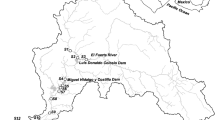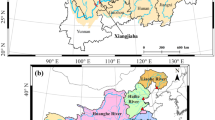Abstract
To control pollutants in rivers, we need to have an understanding of the spatial and temporal variations on nutrients and environmental processes in complex river networks. In this study, 177 sampling sites were located in Jinjiang River in 2017, 15 monitoring stations in Jinjiang River from 2011 to 2016 were also collected. According to the data from the monitoring station, the total phosphorus (TP) and total nitrogen (TN) were the dominant contaminants. By analyzing historical water quality data and up-to-date information about the nutrient concentrations, the secondary canals of the Jinjiang River system, most of which were black and odorous, were much more seriously polluted than the main channel and tributaries. Correlation analysis indicated that the NH3, CODcr, TN, and TP had similar sources (R2NH3-CODcr = 0.572, R2NH3-TN = 0.543, R2NH3-TP = 0.537, p < 0.01). The vertical banks of urban rivers and the inadequate and poorly maintained pipe network systems promote deterioration of water quality in these secondary canals. Overall, our results suggest that the river water quality could be improved if the municipal pipe network systems were better maintained and if the vertical banks were transformed into vegetated buffer strips. This study will support initiatives to improve the water quality and function of the river network ecosystem.






Similar content being viewed by others
References
Aear, D. A., & Mewson, M. D. (2003). Environmental changes in river channel: a neglected element. Towards geomorphological typologies, standards and monitoring. Science of the Total Environment, 310, 17–23.
Bhattacharya, R., & Osburn, C. L. (2017). Multivariate analyses of phytoplankton pigment fluorescence from a freshwater river network. Environmental Science & Technology, 51, 6683–6690.
Callender, E., & Rice, K. (2000). The urban environmental gradient: anthropogenic influences on the spatial and temporal distribution of lead and zinc in sediments. Environmental Science & Technology, 34, 232–238.
David, A. (1995) Stream ecology, structure and function of running waters. Published by Chapman & Hall. Print in Great Britain by Alden Press, Oxford.
Dodds, W. K., Bouska, W. W., Eitzmann, J. L., Pilger, T. J., Pitts, K. L., Riley, A. J., Schloesser, J. T., & Thornbrugh, D. J. (2009). Eutrophication of US freshwaters: analysis of potential economic damages. Environmental Science & Technology, 43, 12–19.
Han, C. L., & Mao, R. (1997). The structure characteristics and the functional variation of the river systems in Taihu Lake catchment. Journal of Lake Science, 9, 300–306.
Hobbies, S. E., Finlay, J. C., Janke, B. D., Nidzgorski, D. A., Millet, D. B., & Baker, L. A. (2017). Contrasting nitrogen and phosphorus budgets in urban watersheds and implications for managing urban water pollution. Proceeding of the National Academy of Sciences of United States of America, 114, 4177–4182.
Kaushal, S. S., Groffman, P. M., Band, L. E., Elliott, E. M., Shields, C. A., & Kendall, C. (2011). Tracking nonpoint source nitrogen pollution in human-impacted watersheds. Environmental Science & Technology, 45, 8225–8232.
Li, K. K., & Li, P. H. (2004). Dujiangyan weir: a shinning pearl of China’s traditional water control culture. China Water Resources, 18, 75–78.
Li, W. Z., Li, X. Y., Wang, H. L., & Su, J. J. (2012). Spatial distribution of the main contamination in aquatic environment in Fuyang River. Journal of Environmental Science, 2, 2814–2819.
Luo, K.Y. (2011). On the relationship between Dujiangyan irrigation system and the “Land of Abundance”-Special study 2 about the ancient “Land of Abundance”, 6, 53–64.
Meng, F., & Liu, M. (2006). Analysis of driving forces and changes in river network under intensive human activity: a case study of Pudong New Area, Shanghai. Resources Science, 42, 15–20.
Morse, N. R., Mcphillips, L. E., Shapleigh, J. P., & Walter, M. T. (2017). The role of denitrification in stormwater detention basin treatment of nitrogen. Environmental Science & Technology, 51, 7928–7935.
Nyenje, P. M., Foppen, J. W., Uhlenbrook, S., Kulabako, R., & Muwanga, A. (2010). Eutrophication and nutrient release in urban areas of sub-Saharan Africa-a review. Science of the Total Environment, 408, 447–455.
Pernet-Coudrier, B., Qi, W. X., Liu, H. J., Müller, B., & Berg, M. (2012). Sources and pathways of nutrients in the semi-arid region of Beijing-Tianjin, China. Environmental Science & Technology, 46, 5294–5301.
Sandahl, J. F., Baldwin, D. H., Jenkuns, J. J., & Scholz, N. L. (2007). A sensory system at the interface between urban stormwater runoff and salmon survival. Environmental Science & Technology, 41, 2998–3004.
Shan, B. Q., Jian, Y. X., Tang, W. Z., & Zhang, H. (2012). Temporal and spatial variation of nitrogen and phosphorus and eutrophication assessment in downstream river network area of north canal river watershed. Environmental Science, 3, 352–358.
Smith, V. H., & Schindler, D. W. (2008). Eutrophication science: where do we go from here? Trends in Ecology and Evolution, 24, 201–207.
Stutter, M. I., Langan, S. J., & Lumsdon, D. G. (2009). Vegetated buffer strips can lead to increased release of phosphorus to water: a biogeochemical assessment of the mechanisms. Environmental Science & Technology, 43, 1858–1863.
Taylor, M., Christopher, T. P., Christine, R., Severin, S., Hans, H. D., Helen, R. P., & Philippe, V. C. (2015). Global phosphorus retention by river damming. Proceeding of the National Academy of Sciences of United States of America, 112, 15603–15608.
USEPA. (1999). Protecting drinking water sources. EPA 810-F-99-015. Washington DC: USEPA.
Vitousek, P. M., Aber, J. D., Howarth, R. W., Likens, G. E., Matson, P. A., Schindler, D. W., Schlesinger, W. H., & Tilman, D. G. (1997). Human alteration of the global nitrogen cycle: sources and consequences. Ecological Applications, 7, 737–750.
Vörösmarty, C. J., McIntyre, P. B., Gessner, M. O., Dudgeon, D., Prusevich, A., Greenm, P., Glidden, S., Bunn, S. E., Sullivan, C. A., Liermann, C. R., & Davies, P. M. (2010). Global threats to human water security and river biodiversity. Nature, 467, 555–561.
Wang, S. Y., Sudduth, E. B., Wallenstein, M. D., Wright, J. P., & Bernhardt, E. S. (2011). Watershed urbanization alters the composition and function of stream bacterial communities. PLoS One, 6(8), e22972.
Yin, C. Q., Su, S. L., Zhang, R. B., Wang, W. D., Zhou, C. D., Liu, J. X., & Zhao, H. T. (2010). Use of wetland to quality polluted stream network for a city water source. Acta Scientiae Circumstantiae, 30, 1583–1586.
Yuan, W., Yang, K., & Xu, Q. X. (2005). Effect of urbanization on growth of Shanghai river function and stream structure. Resources and Environmental in the Yangtze Basin, 14, 133–138.
Zhang, W. Q., Jin, X., Zhu, X. L., Meng, X., Zhu, Y. Y., Zhang, C., Tang, W. Z., & Shan, B. Q. (2017). Do NH3 and chemical oxygen demand induce continuous release of phosphorus from sediment in heavily polluted rivers? Ecological Engineering, 102, 24–30.
Zhao, H. T., Li, X. Y., & Wang, X. M. (2011). Heavy metal contents of road-deposited sediment along the urban-rural gradient around Beijing and its potential contribution to runoff pollution. Environmental Science & Technology, 45, 7120–7127.
Zhao, Y. B., Wang, S. J., & Zhou, C. S. (2016). Understanding the relation between urbanization and the eco-environment in China’s Yangtze River Delta using an improved EKC model and coupling analysis. Science of the Total Environment, 571, 862–875.
Zheng, T. Z., Ni, T. H., Xiong, Y. M., & Liu, G. W. (2001). The prevent and eco-treatment of source water pollution for urban areas, a review. Water Resource Protection, 4, 6–19.
Acknowledgments
We thank Deborah Ballantine, PhD, from Liwen Bianji, Edanz Editing, China (www.liwenbianji.cn/ac), for editing the English text of a draft of this manuscript.
Funding
This work was supported by the National Natural Science Foundation of China (Grant No. 21507146) and the Youth Innovation Promotion Association CAS (Wenqiang Zhang, 2018058).
Author information
Authors and Affiliations
Corresponding author
Additional information
Publisher’s Note
Springer Nature remains neutral with regard to jurisdictional claims in published maps and institutional affiliations.
Rights and permissions
About this article
Cite this article
Zhang, W., Jin, X. & Shan, B. Spatial and temporal variations of nutrition in representative river networks in Southwest China. Environ Monit Assess 190, 707 (2018). https://doi.org/10.1007/s10661-018-7076-6
Received:
Accepted:
Published:
DOI: https://doi.org/10.1007/s10661-018-7076-6




